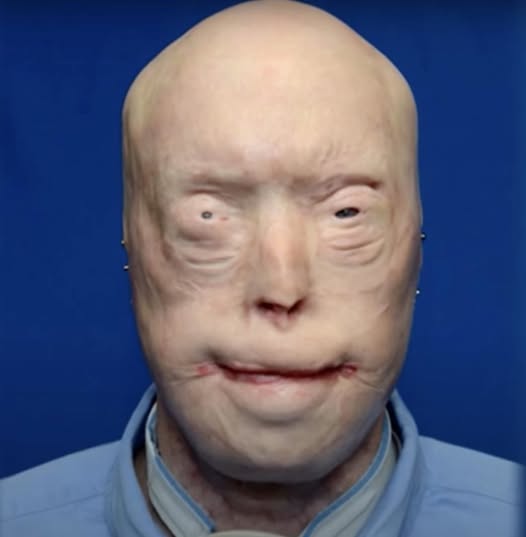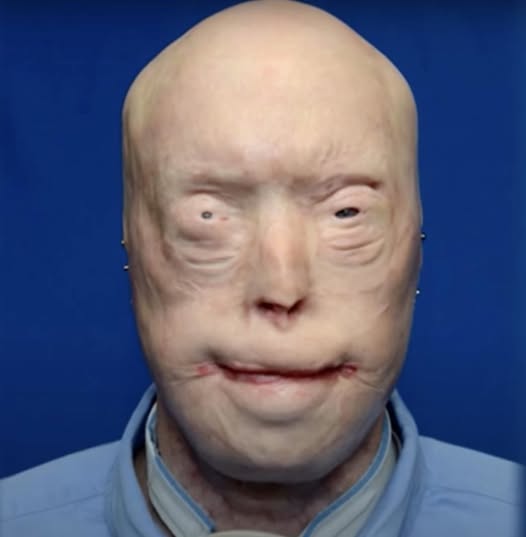
In the fall of 2001, Patrick Hardison, a 27-year-old volunteer firefighter from Mississippi, raced into a burning home, determined to save a life. He had done this before—many times, in fact. Running toward danger was second nature to him. But this call would change his life forever. Trapped under a collapsed roof in a blaze that burned hotter than 1,000 degrees, Patrick was severely injured. By the time he was pulled from the fire, he had suffered third-degree burns across his entire face, scalp, head, neck, and upper torso. His eyelids, ears, lips, most of his nose, and even parts of his facial bones were gone.
For years after that day, Patrick lived in a reality few could comprehend. He underwent dozens of surgeries—71 in total—each an attempt to reconstruct the pieces the fire had taken. Skin grafts were harvested from other parts of his body and stretched over his damaged skin. Pain was constant. Function was limited. Appearance was a ghost of his former self. Simple things became near impossible. He couldn’t blink, which meant he risked losing his eyesight. He had to sleep sitting upright to prevent damage to his unprotected eyes. Breathing was difficult. Eating was a challenge. And wherever he went, people stared—some in horror, others in pity.
To hide from the world’s eyes, Patrick wore sunglasses, a baseball cap, and prosthetic ears. But there’s only so much you can do to shield yourself from judgment. Children would cry at the sight of him. Strangers would whisper. Eventually, he stopped going out entirely. “I didn’t look human,” Patrick once said in an interview. “I looked like a monster to everyone else—and eventually, to myself too.”
Then came a glimmer of hope in 2015.
Doctors at NYU Langone Medical Center had spent years preparing for a groundbreaking medical milestone: a full-face transplant. It would be one of the most complex surgeries in history. The lead surgeon, Dr. Eduardo D. Rodriguez, believed Patrick was a good candidate—if he could survive the procedure. There was a 50/50 chance Patrick would live. It was risky. No one could promise success. But Patrick, who felt he had lost everything already, was willing to take the chance. “If it meant I could live again—not just exist—I was ready,” he said.
The face came from a 26-year-old donor named David Rodebaugh, a young man who had suffered a fatal head injury while cycling. David’s mother made the courageous decision to donate her son’s face, giving another man the gift of visibility, of dignity, of life. On August 14, 2015, the 26-hour surgery began. More than 100 medical professionals worked together in shifts, attaching bones, blood vessels, nerves, and muscles. Patrick received a new face, scalp, ears, eyelids, and parts of the jaw and chin. When it was over, he had not only survived—he had become the recipient of the most extensive full-face transplant ever performed.
Recovery was long and grueling. Patrick spent months in the hospital, monitored for signs of rejection. His immune system had to be suppressed with medication to prevent his body from attacking the donor tissue. There were setbacks and complications, but Patrick remained determined. When he was finally allowed to look in the mirror, he wept—not because he missed his old face, but because for the first time in 14 years, he saw someone whole staring back.
Today, more than seven years after that monumental surgery, Patrick is living a life that once seemed impossible. He plays with his children without fear of scaring them. He speaks at schools, hospitals, and conferences, sharing his story with those who feel broken. He’s become an advocate for organ donation, using his own story as proof of what science, courage, and compassion can achieve.
He has also become a powerful voice in the conversation around resilience and identity. “It’s not about looking the same,” he says. “It’s about feeling human again. It’s about being seen for who I am inside—not just for what happened to me.”
The man who once hid behind sunglasses and prosthetics now faces the world with vulnerability and pride. He’s not ashamed of his scars, nor does he deny the darkness he endured. Instead, he honors every painful step as part of his journey. He knows he’ll need anti-rejection drugs for life. He knows not every day will be easy. But he also knows that life—this second chance he was given—is something to fight for, fiercely and fully.
Patrick’s story isn’t just about surviving an unspeakable tragedy. It’s about what happens when a person refuses to be defined by what they’ve lost. It’s about the power of modern medicine and the selflessness of organ donors. And most of all, it’s about rediscovering life after fire.
Through his strength, Patrick has become living proof that even in the face of the unimaginable, hope can take root. And sometimes, that hope looks like a new face, a new chapter, and a man brave enough to live it.
